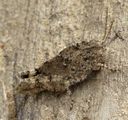Hippiscini
Hippiscini
Classification
- Phylum: Arthropoda
- Subphylum: Hexapoda
- Class: Insecta
- Order: Orthoptera
- Suborder: Caelifera
- Family: Acrididae
- Subfamily: Oedipodinae
- Tribe: Hippiscini
Pronunciation
How to pronounce Hippiscini: //ˌhɪpɪˈskaɪnaɪ//
These audio files are automatically generated. While they are not always 100% accurate, they are a good starting point.
Images






Summary
Hippiscini is a tribe of large, stocky grasshoppers characterized by long antennae and distinctive coloration patterns. They are important herbivores in their ecosystems and include some economically significant species known for forming locust swarms.
Physical Characteristics
Mostly stocky grasshoppers; many species are quite large. The median pronotal ridge is often faintly developed. Antennae are long, especially in males. The tegmina often have pale lines along the top edges. The hind tibiae are usually yellowish to red, with some species exhibiting green or blue hind tibiae.
Identification Tips
Look for the posterior lophi of the male's epiphalus which is typically trilobed. The coloration of the wings can be a helpful identifier—yellow to red or greenish to blue depending on the species. The lack of true crepitation in flight can also aid in identification of Hippiscini.
Habitat
Primarily inhabit xeric weedy fields, with many species adapted to open grasslands and areas with sparse vegetation.
Distribution
Predominantly found in the Americas, though some genera may exhibit broader distributions.
Diet
Herbivorous, feeding on a variety of grasses and other plant materials.
Life Cycle
Most species overwinter as nymphs and emerge as adults in the spring.
Reproduction
Reproduction involves the laying of eggs in the soil or plant matter where the nymphs will hatch in favorable conditions.
Predators
Common predators include birds, small mammals, and other insectivorous predators including spiders and larger predatory insects.
Ecosystem Role
Act as herbivores, playing a role in plant population control and as prey for various predators. Some species are economically important as they can become locusts.
Economic Impact
Some species are important locusts, like Locusta migratoria, which can have significant impacts on agriculture when populations build up.
Collecting Methods
- Sweep nets
- Hand collection
- Pitfall traps
Preservation Methods
- Alcohol preservation
- Pinned specimens
- Drying
Evolution
The group shows morphological and behavioral adaptations that suggest it has evolved alongside its environmental pressures, particularly in dry habitats.
Misconceptions
Some references erroneously suggest that members can crepitate in flight; however, they produce sound from air displacement rather than wing noise.
Tags
- Hippiscini
- grasshoppers
- Oedipodinae
- Acrididae
- insecta